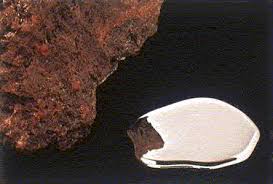Overview
The element mercury (Hg) has atomic number 80, and is considered a transition metal. It is liquid at room temperature. Although mercury is highly toxic, it is a good electrical conductor, and is used in some electrical switches.
Properties of Mercury
Mercury is the only metal that is liquid at room temperature. It is silvery, so it is sometimes called “quicksilver.” Mercury liquid is much denser than water and has a higher surface tension, so that it beads up but does not wet the surface of the substance it floats upon. Like other transition metals, it forms compounds at more than one oxidation level. It has 7 different isotopes.
History of Mercury
Mercury is a relatively uncommon element, and is rarely found free in nature. It is produced from a red ore called cinnabar, mercury (II) sulfide (HgS). Since ancient times, cinnabar was heated to release the mercury vapor. When the vapor cooled, it formed liquid mercury. Cinnabar ore was used in cave paintings in Spain and France because of its red color. Mercury itself was highly prized in ancient China, and believed to have mystical properties. It has been found in Egyptian tombs, and was used during Roman times to purify gold and silver. Alchemists believed that all metals contained some mercury, so that by extracting mercury from them, the metal could be transformed into precious metals such as gold.
Uses of Mercury
Mercury is used now in electrolytic cells, some electrical switches and relays, because of its conduction properties, as well as in fluorescent and mercury-vapor lamps. It was once widely contained in fever thermometers and blood-pressure monitors, but those uses were outlawed because of the metal’s toxicity. It is still used in some scientific monitors, however.
Mad Hatter or Mercury Poisoning?
Mercury and its compounds are highly toxic. During Roman times, prisoners were sentenced to work in cinnabar mines and in processes involving mercury production because the poison would shorten their lives. During the 1800’s the makers of hats prepared beaver pelts and felting using mercury nitrite. Workers inhaled mercury vapor from working in close quarters, resulting in a neurological illness with tremors and dementia, called “mad hatter disease”. In the late 1800s, a new process that did not use mercury was developed, although the phrase “mad as a hatter” remained. In modern times, mercury poisoning is often caused from eating fish that have high levels of mercury from pollution.
Interested in science tutoring services? Learn more about how we are assisting thousands of students each academic year.
SchoolTutoring Academy is the premier educational services company for K-12 and college students. We offer tutoring programs for students in K-12, AP classes, and college. To learn more about how we help parents and students in Taos, NM visit: Tutoring in Taos, NM




